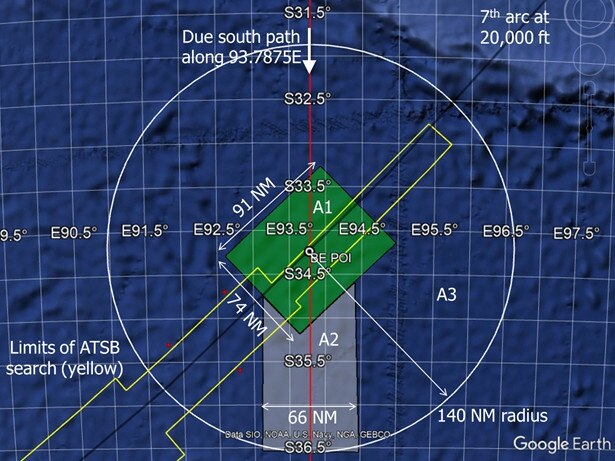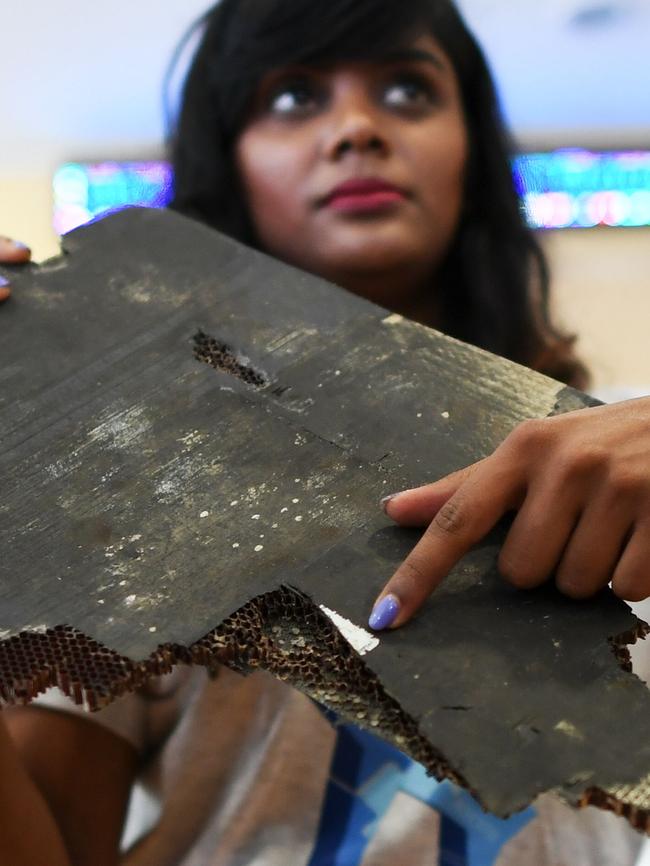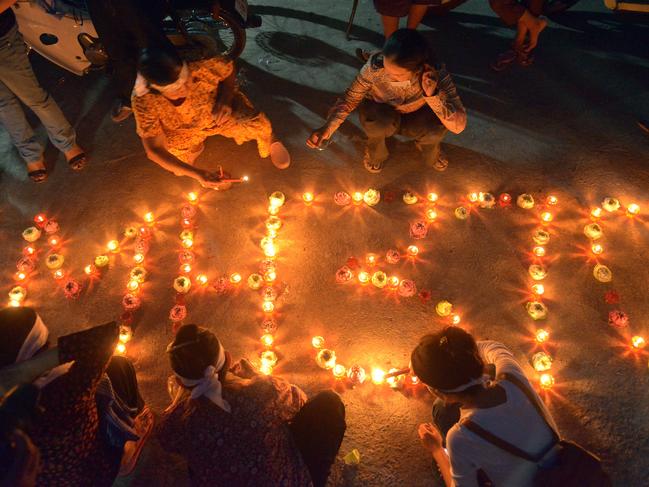MH370 mystery: New search to be launched for missing Malaysia Airlines plane
Three new search areas for missing Malaysia Airlines flight MH370 have been pinpointed in a detailed report by a group of the world’s leading science experts as a new search is set to begin for the doomed flight.
Crime in Focus
Don't miss out on the headlines from Crime in Focus. Followed categories will be added to My News.
Three new search areas for missing Malaysia Airlines flight MH370 have been pinpointed in a detailed report by a group of the world’s leading science experts.
MH370 flying from the Malaysian capital Kuala Lumpur to Beijing vanished on March 8, 2014 with 239 passengers and crew on board after manually being turned around in less than an hour into the flight and was believed lost after running out of fuel somewhere over the Southern Indian Ocean.
A four-year $200 million search over more than 120,000 square kilometre area ended in 2018 with nothing found to detail the aircraft’s final resting place.

But a new report based on revision and refinement of analytics data based on satellite evidence and automated aircraft “handshakes” has defined three new search areas, adjacent to previously searched areas.
They are based on the three most likely scenarios of the final moments of the flight.
Those scenarios include whether a person was in control of the aircraft and ditched it, or whether out-of-fuel it glided on autopilot into the ocean.
The coordinates of the flight’s final trajectory and point of impact deemed the most likely is towards the South Pole at E93.7875° longitude, about 1800km due west from Western Australia’s Margaret River region.
Of the three recommended search areas, highest priority was given to a 6719 square nautical mile grid (23,000 square kms) and assumes no pilot inputs after fuel exhaustion while the second area of 48,400 square nautical miles assumes the aircraft was guided after fuel ran out. The third area is a 166,000km2 circle based on an arbitrary flight path from a fuel exhaustion point.
The revision by data search experts Victor Iannello, Bobby Ulich, Richard Godfrey and Andrew Banks, concluded some of this area has already been searched by authorities using sonar and autonomous underwater vehicles (AUVs) but “the area has challenging terrain with steep slopes, and the debris field may have been either not detected due to terrain avoidance or shadows, or detected but not properly interpreted by reviewers. In particular, there is a steep slope that lies about 20 NM due south of the best estimate point of impact that was not scanned by the towfish (sonar) and appears to have been only partially scanned by the AUVs”.
NEW SEARCH TO BEGIN
Exclusive: A new search for missing Malaysia Airlines flight MH370 is set to be launched this year, with new debris and analysis providing investigators with a clearer priority search to solve what’s been dubbed the world’s greatest aviation mystery.
News Corp can reveal behind the scenes talks have been underway, with families and the Malaysian government to send the world’s leading seabed searchers, Ocean Infinity, on a new quest to find the wreckage of the plane.

The move for a renewed search has been welcomed by former Australian air crash investigators who believed they were rushed into looking for the aircraft in what turned out to be the wrong place.
It comes amid revelations one of the world’s foremost oceanography experts was excluded from the search investigation teams, despite him being the first one to accurately predict where the debris from the plane would wash ashore before any pieces were found.
His drift modelling has so far accurately predicted where 22 of the 32 items believed to be from the missing plane were found.
MORE NEWS
Aussie coronavirus rescue plane lands
Gunman shot dead after Thai massacre
Singles targeted in cruel Insta, Facebook scams
Critically, it is understood the last two pieces of debris found, are potentially an exciting discovery as experts have determined one piece is likely from the internal fin of the vortex generator.
If it is the fin, and part of the engine cowling, it would indicate the engine shattered on impact, supporting the theory that the plane was not in a controlled glide when it went down rather it crashed violently.

Testing of the two pieces of debris was derailed for two years by the assassination of the Honourary Malaysian Consul to Madagascar before he could take possession of the pieces.
The results of the testing have not yet been made public.
The revelations come as an explosive Sky News two-part documentary to air on February 19 and 20 is set to unravel previous searches and reveal the clues that were missed that could now lead to resolution.
MH370 disappeared off radar on March 8, 2014, with 239 people – including six Australians – on-board about 40 minutes into the flight from Malaysian capital Kuala Lumpur to Beijing.
Despite a four-year $200 million search, the aircraft’s final resting place has never been established.
Malaysian lawyer Grace Subathirai Nathan, whose mother Anne Daisy was a passenger of the ill-fated flight, said on Saturday lobbying for a fresh search had been continuing “quietly and privately” with Ocean Infinity, buoyed by a commitment from the 2018 newly appointed Malaysian Transport Minister Anthony Loke.

“We’ve had been getting things rolling so we can make an announcement (this year),” Ms Nathan, who has been the leading advocate for families, said.
“The Transport Minister open to review a proposal.
“We are trying to make sure that the proposal is something that is airtight and doesn’t get rejected for some vague reason so we have been working quietly with parties involved to try and bring that to fruition.”
Ms Nathan said in talks with government she hoped data from the military radar, which tracked the plane that had been deemed national security, was no longer seen as such so investigators could receive fresh information.
“I’m not sure how far along that is, I know there are discussions but I do not know how far discussions have taken root,” she said.
Officials sources close to the negotiations also confirmed the talks but said they were yet to be finalised.
Ocean Infinity CEO Oliver Plunkett said the search was not imminent and the Malaysian Government had rightly set a high bar before committing again to a search on a no find no fee basis.
“As an organisation, we have heavily invested emotionally, as well as financially, in the search, as indeed have many others and consequently there hasn’t been a day since we concluded our search in 2018, that the possibility of a renewed search hasn’t come up in one form or another,” he said, confirming expert opinion on a search location was actively being analysed.

“To that end, while no new search is imminent, we continue to actively engage with a number of subject experts to identify where any new search might be focused.
“It was and remains our position that we hope to be able to offer our services to the Malaysian Government again at some point in the future.”
Former chief commissioner of the ATSB tasked with finding the aircraft Martin Dolan said he would not have done things too differently now but perhaps not rush into a search.
“The only thing that might have been done a bit differently was to spend a little more time assembling all the evidence before resuming the search,” he said.
“We moved fast because there was an expectation that we would move fast following the conclusion of the surface search and this meant that some effort went into areas that were or turned out to be lower priority.
“But that is about the only part of it I think we could have done differently.”
He welcomed talk of a new search.
“The view has already been, there were prospects for covering further areas that were high prospect for finding the plane but understandably governments decided past a certain point that the costs were just too high so any attempt to reopen I think is to be welcomed,” he said.
“It will do two things, if the plane is found it will give us information on what happened but it will also in the end help families draw a line under this tragic event. I welcome any proposal to reopen the search.”

World expert in oceanography UWA Professor Charitha Pattiaratchi said initial drift modelling prepared for the ATSB was fundamentally flawed.
Professor Pattiaratchi, who was excluded from the government oceanographic consulting team, said the modelling had pinpointed debris washing up in Sumatra – which was impossible.
But as soon as the flaperon was found in Africa, he said the sea search should have been suspended and then redrawn.
“As soon as the flaperon was found, we were saying it was unlikely that the plane went down in the search area at that time,” Professor Pattiaratchi said.
But he said the ATSB did not take into account the discovery of the debris and it took another 18 months to acknowledge MH370 was not in their search area.
Minister Loke could not be reached for comment.
WHERE IS MH370?
